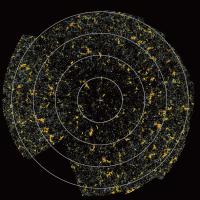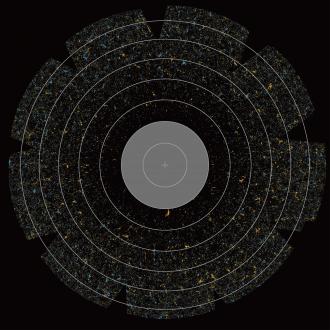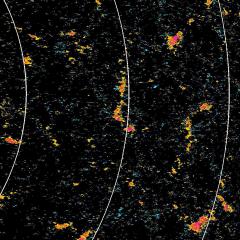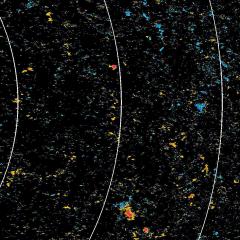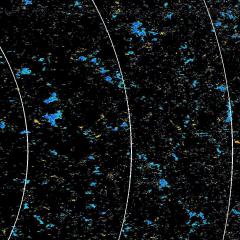Polar Field Reversal as observed with Hinode
RIKEN
Japan Aerospace Exploration Agency(JAXA)
National Aeronautics and Space Administration (NASA)
Science and Technology Facilities Council(STFC)
European Space Agency(ESA)
For the first time in the world, an international research team consisting mainly of researchers from the National Astronomical Observatory of Japan (NAOJ) and RIKEN recently discovered the phenomenon of the polarity of the polar magnetic field in the solar polar region reversing faster than expected by using the Solar Optical Telescope (SOT) mounted on the Solar Observation Satellite "Hinode." This discovery was brought about by the SOT's high spatial resolution and high-precision polarimetry, and the long-term operation steadily conducted via the "Hinode" satellite.
At present, solar activity has passed the solar minimum and is increasing slightly. Looking at the overall picture, the solar magnetic field in this solar minimum shows that the north polar region has negative polarity and the south polar region has positive polarity. The polarity of both the north and south polar regions is expected to reverse in May 2013, around the same time as the solar maximum, which is the period with the largest average number of sunspots.
The Sun's polar magnetic field is considered to be the origin of sunspots which are known to be the source of solar activity. That behavior will be very important in forecasting solar activity in the future. In the past, polarity reversal was observed by solar telescopes on the ground. Consequently, only the average strength and polarity of the magnetic fields was found due to the lack resolution, and it was not possible to know what was occurring in the solar polar region.
Based on observations conducted with high spatial resolution and high-precision polarimetry of the SOT aboard the "Hinode" satellite in September of 2007, magnetic field patches, which were broad and spotty, with a magnetic field strength comparable to sunspots, were discovered for the first time, scattered in the solar polar region. (Reference: Press release "'Hinode' discovered strong magnetic field patches in the Sun's polar region.")
Since that, the "Hinode" satellite has been conducting polar observation regularly for four years, during which solar activity passed the solar minimum and has been increasing. As a result, it was discovered during observations conducted in January 2012 that the north polar magnetic field was dwindling close to almost zero, one year earlier than expected. That is to say, the number of magnetic field patches, which play the role of magnetic field spots in the north polar region, decreased rapidly and spots of opposite polarity emerged at low latitudes. (Figures A and B) Consequently, it is considered that there is a large scale disappearance of the opposite polarity magnetic field and polarity reversal occurring in the north polar region of the sun.
According to these observations, the north polar magnetic field is forecast to shift from negative to positive polarity soon. On the other hand, surprisingly, the "Hinode" has confirmed that there are few signs of polarity reversal in the south polar field, and it is steadily maintaining positive polarity.(Figure C) Generally speaking, the solar magnetic field has a bipolar configuration; like a bar magnet, for example, the sun's south and north polar regions have a positive and negative polarity structure respectively. However, according to observations by "Hinode," it is assumed that the solar magnetic field will be a quadrupole structure, where both the north and south have positive polarity. Numerical calculations are being performed to understand the structure of the solar magnetic field based on the "Hinode" observation data.
Solar polar observation is extremely important for forecasting solar activity in the future. The solar minimum, which is the period from the end of the previous solar activity cycle to the beginning of the current cycle, has continued longer than expected (An ordinary solar cycle is approximately 11 years, while the current cycle is 12.6 years). Also, up until now, current solar activity has been more sluggish than previously. Furthermore, signs that the large solar magnetic field has changed to a quadrupole structure were discovered by the current "Hinode" observations. These research results show that the solar dynamo, which is a process generating magnetic fields within the Sun, is bringing about changes seen for the first time since the start of modern-style solar observation. It is believed that the Sun has previously experienced these circumstances during the Maunder Minimum and Dalton Minimum, which are said to have been periods when the Earth's climate was colder. Attention will be paid to future changes.
These research findings are highly important results, which will revolutionize conventional wisdom regarding the polarity reversal process in the solar polar magnetic field. Intensive observation of the north polar region is scheduled to be conducted around October 2012 in order to clarify future change. Thanks to the advancements in observation by the Solar Observation Satellite "Hinode," understanding is expected to grow related to basic research on the solar dynamo and the influence of solar activity on the global environment.
The magnetic landscape of the sun's polar region taken on Sep. 2007 (left) and Jan. 2012 (right).
The close up view near the north pole 70-85 degrees, taken on Sep. 20 2008 (left) and Oct. 9 2011 (right).
The close up view near the south pole 70-85 degrees, taken on Mar. 20 2009 (left) and Mar. 24 2011 (right).
Regarding the use of images and movies on the page concerned, please visit the page here. The credits of images and movies on this page are “NAOJ/JAXA” unless explicitly stated to the contrary. Regarding images and movies on this page the credits of which are “NAOJ/JAXA”, "NAOJ/JAXA/MSU", or “NAOJ, JAXA, NASA/MSFC”, terms of use for Copyrighted Works owned by NAOJ can be applied. In using the images and movies, the credits should be given.

